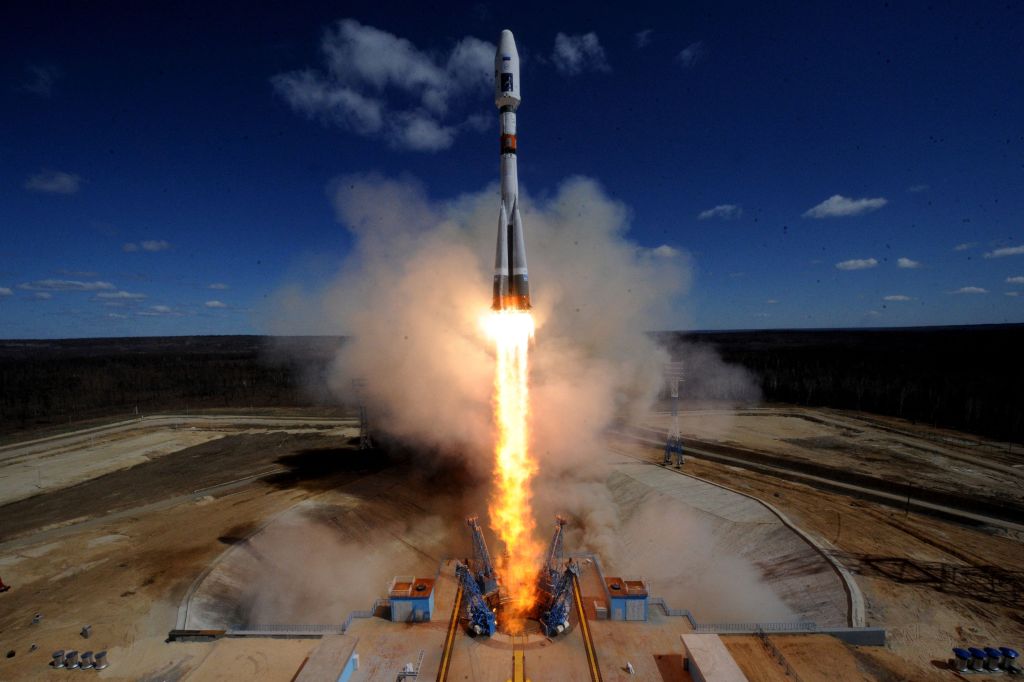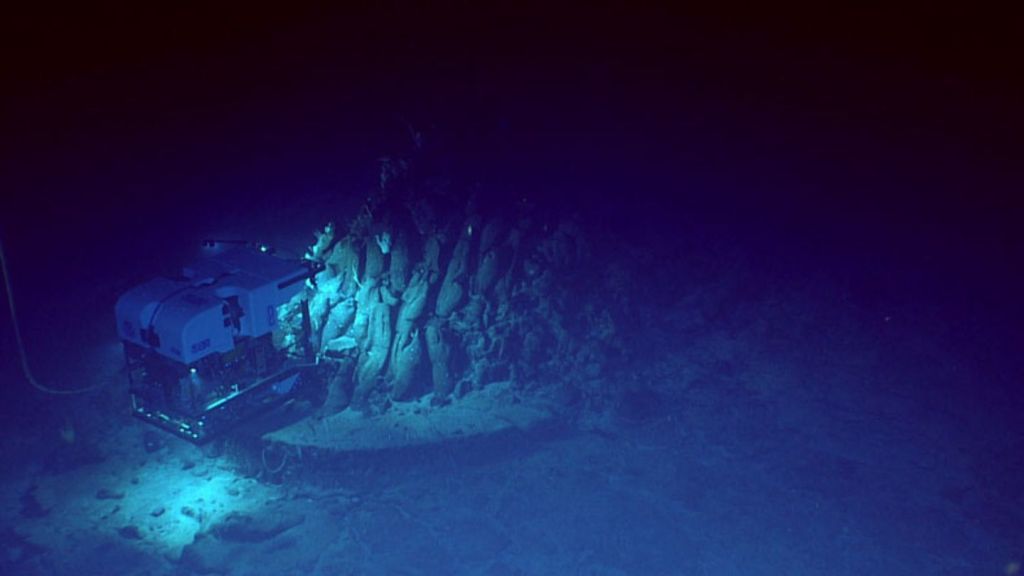Apollo 18 came out this past weekend. Previews suggested a Blair Witch Project meets Apollo 13 style hybrid featuring found footage of a secret lunar mission that promised to shock me to my core. I was sceptical, but I’m also an Apollo-era historian so of course I went to see it.
The movie has a great premise. a secret moon landing that went so terribly wrong the government had to cover up all traces of the mission. It had real potential to be a fun “what if” playing off the pseudo-mystery of why we’ve never been back to the moon. But it went in the other direction and played into the common conspiracy theories that we haven’t returned to the moon since 1972 because of aliens; disregarding solid science and political constraints. Aliens are the real reason.
Videos by VICE
In the movie, the crew is sent on a secret lunar mission by NASA and the Department of Defense. It moves along slowly, dominated by house keeping procedures from mission control and often lewd banter between the three men in the spacecraft. As soon as two of the three astronauts take the lunar lander onto the surface, however, things quickly get crazy. If you haven’t see the movie and want to be surprised, you should probably skip the next two paragraphs.
During their first extravehicular activity (EVA) on the surface, the astronauts follow mysteriously human footprints to discover an abandoned Soviet lunar lander and the body of a cosmonaut. This disturbing find is downplayed by mission control, but the arrival of an eerie disturbance affecting the astronaut’s voice communications line is not. Things get ‘real’ on the second EVA when non-human tracks are found and the commander finds that there’s something moving in his suit. It turns out the rocks on the moon are actually spider-like creatures that can enter the human body and cause a devastating and fatal infection.
As the situation becomes worse, the astronauts fight and jump shots show the commander succumbing to sickness and getting increasingly creepy-looking before deciding to sacrifice himself to try and save his friend’s life. Electrical problems in the lunar module force the remaining astronaut to flee across the lunar surface to the Russian lander, learn to fly it, and try and rendezvous with his third crew member in orbit. But he too has been infected, and NASA leaves the whole crew to die in lunar orbit.
This unbelievable story wasn’t what I had hoped for. I was looking forward to something plausible like space madness: the commander snaps, cuts the stay on the moon short, and in a moment of insanity opens the command module’s hatch in orbit, instantly killing himself and his crew. Sure it’s unlikely (that’s why astronauts go through psychological testing), but it’s at least in the realm of possibility.
Apollo 18 presents itself as a documentary. There are no credited actors or production crew save the company that spliced the movie together from the found footage. It directs movie goers to visit www.lunartruth.org – the site where the found footage was uploaded after being leaked from NASA. Adding to the found footage feeling, the movie starts with a recap of the space race as if to lend context to the Apollo 18 mission. Archival NASA footage of the lunar module’s production, Apollo 17’s launch, and Apollo 11’s view from lunar orbit provides the lead-in and gives the sense that everything you’re about to see is in fact real.
NASA has hundreds of hours of video and audio records of the Apollo missions the movie’s writers could have used to build a truly believable script. Instead, the astronauts inexplicably keep announcing the mission elapsed time with every video transmission (the actual footage was timestamped), there is an echo on the voice loop (this doesn’t make any sense), and there’s even a scene with one astronaut shaving before heading out onto the lunar surface (weight was a huge concern and shaving supplies definitely weren’t worth taking to the moon).
A quick Google search of “Apollo 18” reveals that I’m in the minority for finding this obvious work of fiction too saturated by the magic of Hollywood to be at all believable. Message boards are filled with debates about the truth of the film and bloggers are coming out in droves adding to the numbers who believe Apollo 18 uncovers a decades old conspiracy.
Reactions to the film are varied but generally fall into one of two categories: People either seem to believe that the movie is real found footage or a dramatization of found footage, or that it’s not real, but a story made up to begin peeling back the layers of the real Apollo 18 mission. A lot of people seem to think the film was inspired by the very real and very covered-up Apollo 19 and 20 lunar missions.
Another Google search turns up a world of conspiracy theories I never knew existed. Since sarcasm is hard to convey in writing, I hope readers can take these next few paragraphs not with a grain of salt, but with a some equivalent of a jawbreaker made of salt.
In 2007, American-born Rwanda resident William Rutledge surfaced on Youtube claiming to be the commander of Apollo 20. Going by the screen name “retiredafb,” Rutledge, posted cryptic videos of his lunar mission (the above clip). The videos were fragments, but pieced together hints of a joint US/Soviet lunar mission sent to investigate an object found in a crater. The object turned out to be an alien ship; Rutledge’s videos show documents with alien writing before revealing a preserved alien body recovered and returned to Earth.
The footage caught the attention of the Italian journalist, Luca Scantamburlo who contacted Rutledge through Youtube comments and posted videos. Their correspondence served as the basis for Scantamburlo’s exclusive interview with the commander of the secret mission; Rutledge said he would only speak to one media representative.
Rutledge added details to the videos posted online. The crew of Apollo 20 was Rutledge, Leona Snyder (thus opening up controversies on who was the real first American woman in space), and Alexei Leonov. Of the three, Leonov is the only name of a real man who flew during the space race. Leonov was the first to perform an EVA in March 1965, but that was in low Earth orbit, not on the moon. The mission launched from Vandenberg Air Force Base, which is why it was never a public one. The mission was covered up because of its (literal) alien nature.
Inspired by Rutledge’s bravery, the commander of Apollo 19 contacted Scantamburlo with his own exclusive story of a secret mission. The unnamed commander goes by the username “moonwalker1966delta” told his story like Rutledge through Youtube comments.
Moonwalker1966delta tells that Apollo 19, also launched secretly from Vandenberg Air Force Base, was launched with the intention of investigating the same alien ship as Apollo 20. Not long after launch, however, the mission ran into unexplained telemetry problems that resulted in the loss of the spacecraft. Somehow, the commander alone survived to tell the tale.
These stories are widely cited as the inspiration for Apollo 18. Some are suggesting that Apollo 19’s goal and Apollo 20’s other charge was to recover the videos left on the surface by the deceased Apollo 18 crew.
The other piece of the conspiracy puzzle floating around is NASA’s decision to distance itself from Apollo 18. Conspiracy theorists are quick to assume that this is clear evidence of a cover up. If it’s really fiction, why wouldn’t NASA want to participate? What’s the harm?
Evidently, it was the film’s decision to claim fiction as fact that prompted NASA’s distance. Without even seeing a final cut of the movie, the organization deemed the storyline too unbelievable and a poor representation of NASA’s activities. By removing itself from Apollo 18, NASA hopes to draw a clear line between fact and fiction; support for the film could be more easily construed as admission of secret lunar missions. In the end, NASA allowed filmmakers to use archival footage and logos that appear on the astronauts suits – logos are the only piece of the organization that the public cannot use without permission.
In all this wild conspiracy hunting and claims of a NASA cover up, not one conspiracy theorist has found references to the actual Apollo 18 flight.
In the early 1960s when the Apollo program was in the earliest planning stages, the plan was for a prolonged manned exploration of the moon. Every mission would stay a little longer on the lunar surface and travel a little further such that by the end of the program a good percentage of the moon’s surface would be well mapped and explored. In the mid 1960s, lunar missions were planned ending with Apollo 20.
This was not to be. Budget constraints, fears of astronaut safety, and questions of the hardware’s ability to support prolonged lunar missions led to the cancellation of three missions. The program ended in 1972 with Apollo 17. (A more detailed course of events surrounding planning and cancellation of Apollo missions can be found here).
But there was leftover hardware from the cancelled missions. Some was put to use in the short lived Skylab program, which put three crews into Earth orbit in Apollo command service modules in 1973. In 1975, the last Apollo spacecraft flew as part of the Apollo-Soyuz Test Program (ASTP) – the first real joint US/Soviet mission. The Apollo half of the mission – manned by Tom Stafford, Deke Slayton, and Vance Brand – was formally designated as Apollo 18 though seldom referred to as such. Their Soviet counterparts in Soyuz 19 (also referred to simply as Soyuz) were Valeri Kubasov and Alexei Leonov.
NASA’s records of cancelled Apollo missions include Apollo 18, and the fact sheet of the ASTP references Apollo 18, but this is hardly evidence of a conspiracy. Rather, it’s evidence that Apollo spacecraft flew after the end of the lunar exploration program. Still, conspiracy theorists are having a field day. Luckily, it’s really entertaining for the rest of us!



